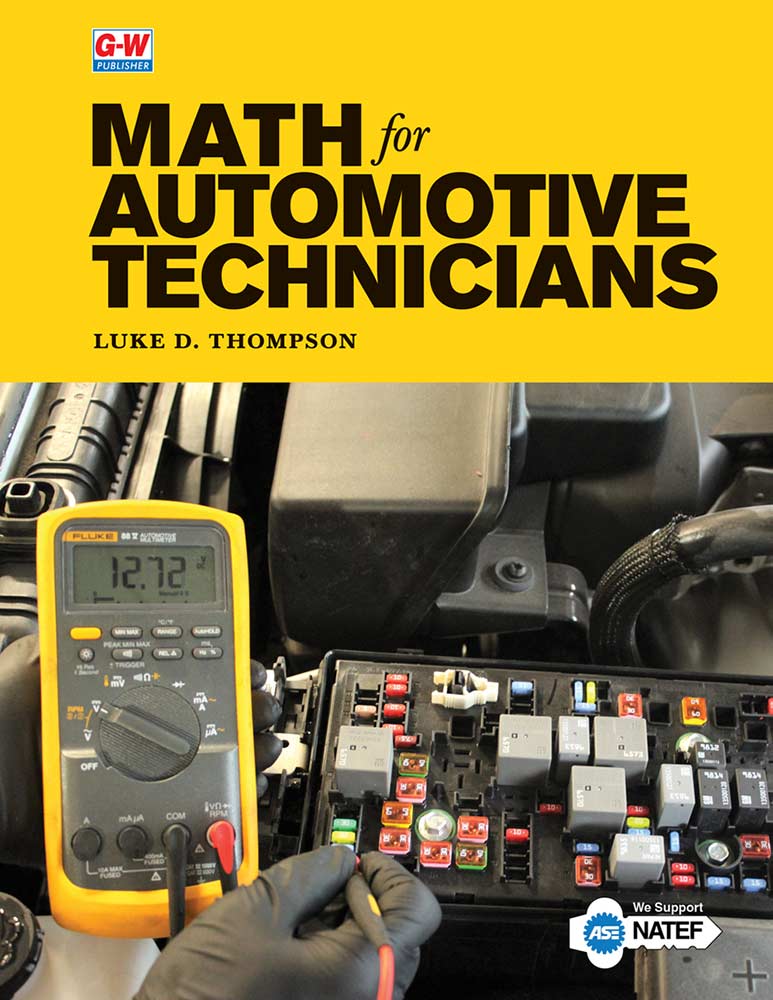Math for Automotive Technicians
By: Luke D. Thompson, M.Ed.Copyright: 2019
Subject: Automotive
Grade Level: 9-14
- Math for Automotive Technicians is designed to help students learn and apply basic math skills. The first part of the text provides 12 lessons that develop a mastery of basic math skills in the context of automotive service. Coverage includes whole number operations, decimals, greater than/less than, tape measure fractions, conversion, graphs and tables, formulas, measurement, and comparing to specifications. The second part consists of 96 case studies that apply and extend the basic math skills with actual vehicle procedures, data, and specifications. For ease of integration with curricula based on the NATEF standards, the case studies are grouped into automotive service areas, such as chassis systems, engine mechanical, electrical, etc. Answers to odd-numbered practice problems are listed in the back of the text.
- Units begin with Career Profiles based on interviews with practicing automotive technicians who explain how and why math is important to their work. The Career Profiles provide context and motivation for students and answer the question "why study math?"
- Word problems use realistic automotive examples; case study practice problems are well illustrated and correlate to the NATEF tasks lists.
- Word problems also reference Concern-Cause-Correction language, which integrates a diagnostic problem-solving model with mathematical problem-solving.
- Math for Automotive Technicians is well suited for use as either the core text in a dedicated applied math course or as a supplemental text in an automotive technology program.
- Products & Prices College & Career
- Table of Contents
- Unit 1—Math Skill Lessons1. Addition
2. Subtraction
3. Multiplication
4. Division
5. Decimal Arithmetic
6. Greater Than and Less Than
7. Fractions
8. Conversion
9. Graphs and Tables
10. Formulas
11. Measurement
12. Analyzing SpecificationsUnit 2—Around the Shop13. Work Uniforms—Addition
14. Shop Inventory—Subtraction
15. Scrap Metal Pricing—Multiplication
16. Paying for Professional Tools—Division
17. Flat-Rate Labor Times—Decimal Arithmetic
18. Customer Service Surveys—Greater Than and Less Than
19. Hose Length Calculations—Fractions
20. Fluid Volume—Conversion
21. Workplace Productivity—Graphs and Tables
22. Wage Earnings—Formulas
23. Shop Equipment—Measurement
24. Vehicle Identification Number—Analyze SpecificationsUnit 3—Vehicle Maintenance25. Repair Orders—Addition
26. Timing Belt Service Intervals—Subtraction
27. Maintenance Parts—Multiplication
28. Brake Pad Life—Division
29. Analyzing Battery Voltage—Decimal Arithmetic
30. Pressure Sensor Data Analysis—Greater Than and Less Than
31. Tire Tread Depth—Fractions
32. Torque Values—Conversion
33. Coolant Freeze Levels—Graphs and Tables
34. Torque—Formulas
35. Tires and Wheels—Measurement
36. Engine Tune-up—Analyze SpecificationsUnit 4—Chassis37. Unsprung Weight—Addition
38. Service Intervals—Subtraction
39. Tire Size Aspect Ratio—Multiplication
40. Stopping Distance Factors—Division
41. Alignment Angles—Decimal Arithmetic
42. Analyzing Tires—Greater Than and Less Than
43. Ride Height Measurements—Fractions
44. Linear Measurement—Conversion
45. Brake Fluid Testing—Graphs and Tables
46. Tire Diameter—Formulas
47. Disc Brake Micrometer—Measurement
48. Brake System—Analyzing SpecificationUnit 5—Engine Mechanical49. Valve Overlap and Duration—Addition
50. Camshaft Lobe—Subtraction
51. Rocker Arm Ratio—Multiplication
52. Compression Ratio—Division
53. Engine Block Calculations—Decimal Arithmetic
54. Piston Bore Clearance—Greater Than and Less Than
55. Engine Parts—Fractions
56. Engine Size—Conversion
57. Cooling System—Graphs and Tables
58. Engine Power and Efficiency—Formulas
59. Cam and Crank Journal—Measurement
60. Cylinder Bore—Analyzing SpecificationsUnit 6—Electrical61. Voltage Drop—Addition
62. Reference Voltage—Subtraction
63. Ohms Law Part 1—Multiplication
64. Ohms Law Part 2—Division
65. Applying Ohms Law—Decimal Arithmetic
66. Wire Gage—Greater Than and Less Than
67. Wire Length—Fractions
68. Temperature—Conversion
69. Graphing Ohms Law—Graphs and Tables
70. Electrical Resistance—Formulas
71. Digital Multimeter—Measurement
72. Electrical System Specifications—Analyzing SpecificationsUnit 7—Engine Performance73. Electronic Throttle Controls—Addition
74. Mass Air Flow Calculation—Subtraction
75. Ignition Coil Voltage—Multiplication
76. Analyzing Compression Testing—Division
77. Fuel Trim—Decimal Arithmetic
78. Spark Plug Gap—Greater Than and Less Than
79. Fuel Tank Capacity—Fractions
80. Pressure—Conversions
81. Engine Sensors—Graphs and Tables
82. Lambda—Formulas
83. Vacuum Pressure Gauge Reading—Measurement
84. Module Pinout Diagrams—Analyzing SpecificationsUnit 8—Driveline85. Multi-Disc Clutch Adjustments—Addition
86. Driveline Angle Calculations—Subtraction
87. Gear Ratio Torque—Multiplication
88. Differential Gear Ratios—Division
89. Hydraulic Pressure—Decimal Arithmetic
90. Planetary Gear Set Ratios—Greater Than and Less Than
91. Gear Ratio—Fractions
92. Odometer Distance—Conversions
93. Transmission Shift Solenoid—Graphs and Tables
94. Driveline Speed—Formulas
95. Gear Backlash—Measurement
96. Differential Backlash—Analyzing SpecificationsUnit 9—Air Conditioning and Hybrid Technology97. Air Conditioning System Oil—Addition
98. Compressor Clutch Air Gap—Subtraction
99. Hybrid Vehicle High-Voltage Battery—Multiplication
100. Electric Car Speed and Acceleration—Division
101. Cooling System Boiling Point—Decimal Arithmetic
102. Hybrid Vehicle Payback—Greater Than and Less Than
103. Evaporator and Condenser Area—Fractions
104. Refrigerant Weight—Conversions
105. Air Conditioning System Pressures—Graphs and Tables
106. Miles per Gallon Equivalent—Formulas
107. Air Conditioning Gauge Readings—Measurement
108. Hybrid Electric Fuel Economy—Analyzing Specifications - The Look Inside images are for preview purposes only. The format of the actual product may vary from the images shown.
- About the Author(s)


